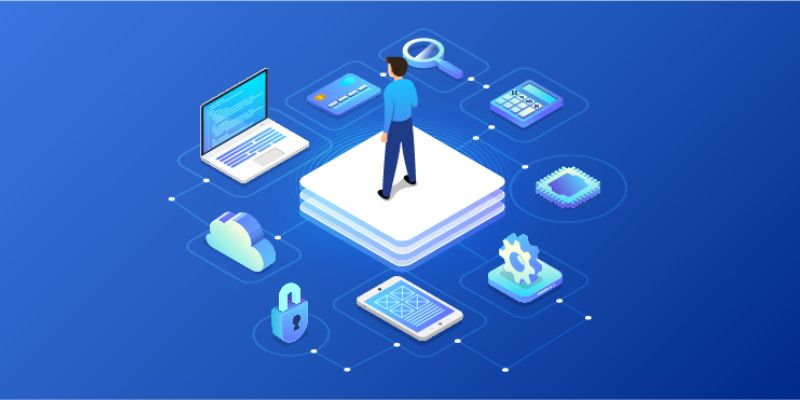Digital Transformation Success: How Top Companies Are Winning Big
Imagine your company hitting the jackpot. Now, think bigger. That’s the impact digital growth can have, and I’ve seen it with my own eyes. Examples of companies that thrived with digital transformation aren’t just stories; they’re real-world lessons in winning the future. From retail chains that turned shopping into seamless fun, to banks reshaping how we keep our money safe—they’re all winning big. I’ll walk you through how they flipped the script, all while keeping tech at their core. Heads up: it’s time to rev up your digital engines and get inspired by the best in the biz. Buckle up!
Embracing New Realities: Pioneering Business Model Innovation
Retail Chains’ Digital Strategies That Revolutionized Shopping
Let’s talk shop, literally. Big retail chains saw the digital wave coming. They jumped right in and made waves themselves. They didn’t just splash around. They changed the game. Think about how we shop today. It’s nothing like ten years ago. Why? Retailers got smart. They used tech to make buying cool and so much easier.
Take Walmart, for example. They turned smartphones into super shopping tools. With their app, you can check out by scanning your stuff. No lines. Big win for busy shoppers. They went even bigger, with robots in aisles checking stock. This means they rarely run out of what you need. Plus, the data these robots gather helps Walmart know what you like. Then they make sure to keep it around.
Target isn’t sleeping on tech either. They’re all about making shopping a breeze. They mix online and store shopping. This omnichannel approach lets you pick how you get your stuff. Buy online, grab it in-store. Or get it parked in your car spot outside. You don’t even have to turn off your engine!
These stories show us one big thing. Retail chains that use digital moves well, win big. They use tech to make your buy trips quick and fun. And it’s working. They keep us coming back with easy apps, fast check-outs, and never-ending stock.
Banking Sector Tech Advancements That Reshaped Finance
Next up, banks. Old-school banks had us all yawning. Long lines, lots of paperwork, and slow service. No fun, right? But the smart ones saw change coming. They grabbed their surfboards and rode the digital tidal wave.
Let’s unpack what they did. They put banking in our pockets. Mobile tech means we tap, swipe, and pay bills or send cash from anywhere. No more lines. No more waiting. Just grab your phone and you’re the bank.
Banks like JPMorgan Chase used AI to make smarter decisions. Things like giving loans. It helps them take smart risks. And helps us get faster yes’s. They didn’t stop there. They’re using data analytics. This means they understand us better. They know what we need before we do. Then they whip up new services that fit just right.
Above all, these changes mean banks work better for us. They’re quicker, they use our data smartly, and they’re always at our fingertips. They went from stuffy to streamlined. It shows how much we can gain when companies ride the tech wave well.
In both retail and banking, the message is clear. Dive into digital, use data smartly, and make life easier for customers. You’ll not just survive the tech storm. You’ll thrive and come out a winner.

Integrating New Technologies: Tales of Transformation
Healthcare Digitalization Examples Leading Better Patient Care
Let’s talk about how hospitals are changing the health game. They’re using computers and the web to make things better for patients. Big hospitals like the Cleveland Clinic are now using digital records. This means quick access to patient files, leading to better and faster care.
So, why does this matter? With all the facts in one place, doctors can make smarter choices, fast. No more waiting on papers that are hard to find. Everything’s at their fingertips. And it gets better. They’re using smart programs to spot health issues before they get worse. Patients get help early, and doctors can stop problems before they start.
Healthcare digitalization keeps folks out of the hospital, too. With tech like video chats, patients and doctors can talk without a visit. This saves time and gets folks the help they need, anywhere they are.
Manufacturing Industry IoT Integration Boosting Efficiency
Now, let’s shift gears to factories and how cool tech is shaking things up. Factories are getting smart by using the Internet of Things (IoT). This is like giving machines the power to talk to each other.
For example, General Electric’s factories are now using sensors on machines. They tell workers when a part needs fixing. This way, things don’t break down and slow the work. The smart tech also looks at how the factory is doing every day. It finds ways to do things better and faster, without using more stuff.
This is great because it saves money and makes less waste. But it’s not just about cash. It’s about staying top notch in a world where things are always changing. The ones who move fast with tech stay ahead. And they get to lead, not just follow.
So there you have it, real stories showing us how the big leap to digital makes all the difference. Hospitals and factories aren’t just doing things the new way. They’re setting the stage for a future that’s smarter and more connected. That means better care for us, and better ways to build and make things, all thanks to the power of tech.

Enhancing Customer Interactions: Transforming Customer Experience
Omnichannel Strategies Success in Unified Consumer Engagement
Imagine you can shop online, on your phone, or in a store without any hassle. That’s what top retailers have done with omnichannel strategies. They make buying things easy no matter how you shop. This has led to more happy customers and better sales. For example, companies like Disney and Starbucks use apps, websites, and stores to give everyone a great time, from anywhere.
Omnichannel isn’t just about having multiple ways to buy. It’s about connecting all these ways. So, if you buy something online, you can return it at a store. Or you can check online to see if your local store has what you want. Big names in retail have seen big wins by doing this. It keeps people coming back, and that’s a win for the business.
Leveraging Digital Tools for Improved Customer Retention
Keeping customers is key for any business. The best companies use digital tools to do this. With these tools, they can offer fast service, help with problems, and even reward you for being loyal. Let’s take Amazon as an example. They use data to suggest things you might like. This keeps you interested and more likely to buy again.
Digital tools also let companies keep tabs on how you use their services. If they see you’re not happy, they can step in to make things better before you even ask. It’s like having someone always ready to help you out. This smart move means people will choose them again, boosting their sales and growth.
By using technology right, companies can create a strong bond with their customers. This means doing more than just selling things. It’s about creating an experience that you will remember. That’s how the smart companies stay ahead and keep you coming back for more.

Data-Driven Decisions: Leveraging Analytics for Growth
Big Data Exploitation by Firms for Market Insights
Think of big data as an endless gold mine. Firms dig deep into this mine to understand you, the customer. This info helps them give you what you want before you even ask. Let me paint a picture for you. A top online retailer, like Amazon, uses your shopping patterns to suggest new items. Their suggestions often feel like they read your mind, right? That’s big data at work. They crunch numbers, see trends, and then boost sales. They stay ahead because they know what’s hot and what’s not.
Machine Learning for Business Insights Generating Value
Now, let’s throw machine learning into the mix. It’s like having a super-smart friend who learns everything about your business in minutes. This friend then tells you, “Hey, if you change this tiny thing, you’ll save a ton of money!” One famous example is Netflix. They used machine learning to figure out what shows you binge-watch. Then, they made their own shows based on what you love. This clever move keeps you glued to your screen, membership active, and their profits soaring.
Smart, right? These stories show us that with the right tech and ideas, businesses can reach new heights. By using data and learning from it, they turn info into cash and happy customers. That’s the winning ticket in today’s digital world!
We’ve explored the big shifts businesses are making today. From online shopping shake-ups to banking tech leaps, these changes are all around us. In healthcare and manufacturing, digital tools have brought about smarter, faster ways to work. It’s all about connecting with folks where they are, keeping them happy and coming back for more. Big data’s role? Huge. It helps companies to peek into the future and make smart moves. So here’s the take-home: tech’s not just fancy gadgets. It’s a game-changer for how companies serve you better and stay ahead. Keep an eye out – the best is yet to come.
Q&A :
What are some success stories of businesses that embraced digital transformation?
Digital transformation has enabled numerous companies across the globe to reinvent their business models, streamline operations, and enhance customer experiences. Tech giants like Adobe successfully transitioned from a product-sales model to a cloud-based subscription service, thereby increasing their market share and revenue. Meanwhile, Domino’s Pizza leveraged digital technology to enhance ordering through various platforms and is often cited as a more of a tech company than a fast-food chain due to its innovative digital strategy.
How has digital transformation propelled companies to new heights?
Digital transformation has been a key driver for growth and competitiveness in many industries. Companies like Netflix changed the entertainment landscape by shifting from DVD rentals to streaming services, thus cultivating a massive subscriber base and reshaping media consumption. Similarly, Microsoft magnified its business by transitioning to cloud computing and focusing on its Office 365 suite and Azure platform, resulting in sustained growth and resilience in a rapidly changing tech landscape.
Which industries have seen the most profound impact from digital transformation?
Digital transformation has had a pivotal impact across virtually every industry, but some have been particularly transformative. The retail sector, exemplified by companies like Amazon, has undergone a massive shift towards e-commerce, affecting consumer behavior and expectations. Financial services have also dramatically changed, with fintech companies like PayPal and Square offering digital payment solutions that alter how transactions are processed. Lastly, automotive companies like Tesla have incorporated digital technology into their products and sales models, leading to significant advancements in electric vehicles and sustainable transport solutions.
Can small businesses also benefit from digital transformation?
Absolutely, digital transformation isn’t just for large corporations. Small businesses can reap substantial benefits by adopting digital tools and strategies. By leveraging CRM software, social media platforms for marketing, and e-commerce for online sales, small businesses can enhance customer engagement, improve operational efficiency, and expand their reach. Case studies often highlight how small retailers or local service providers grew their brand presence and revenue streams by smartly integrating digital technologies into their business practices.
What are the essential elements of a successful digital transformation strategy?
A successful digital transformation strategy relies on several core pillars: clear leadership and vision, customer-centricity, agile operations, digital skills development, and data-driven decision-making. Companies that excel in digital transformation, like Amazon and IBM, demonstrate a commitment to constant innovation and user experience improvement. They also recognize the importance of cultivating a culture that is adaptable and tech-savvy, using data analytics and AI to inform strategic moves and personalize services. These elements combined enable a robust response to market changes and technological advancements.



